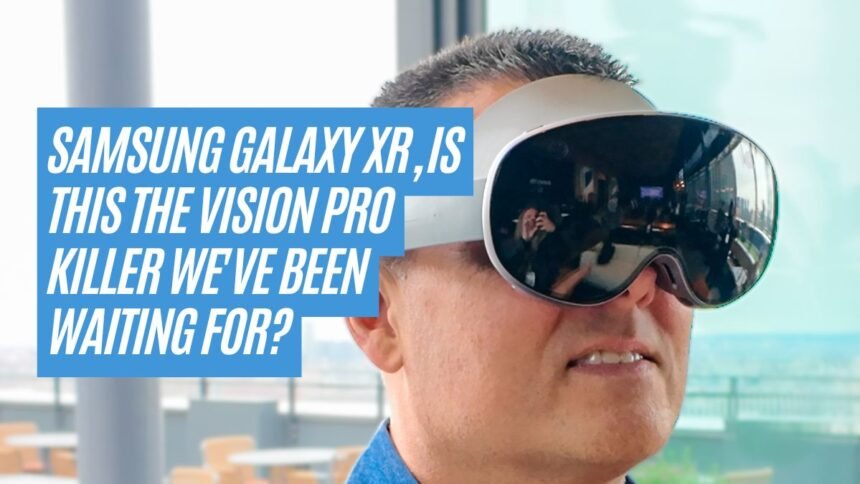Samsung is now officially part of the mixed-reality realm, thanks to the recent release of its new Galaxy XR headset as direct competition to Apple’s Vision Pro. The Galaxy XR is an iPhone wannabe with the same sorts of specs, but a much more reasonable $1,799 price. The reveal, after months of buildup, occurred this week at a virtual product launch.
The introduction of the Galaxy XR represents a key landmark in Samsung’s journey in XR that began with an announcement February 2023 to join forces with Google and Qualcomm. It is compatible with Google’s Android XR software platform as well, and packs a Snapdragon X2 Plus Gen 2 SoC. It will also have an on-device Gemini Assistant to bring the AI directly to the user mixed-reality experience.
“Samsung’s role is to take innovation to scale and move the concept of XR to everyday life,” stated a Samsung executive during the virtual launch. This ambition extends beyond the Galaxy XR, with the company confirming plans to develop other Android XR-based devices, including augmented reality glasses in partnership with Warby Parker and Gentle Monster.
The Galaxy XR is currently available for purchase in the U.S. and Korea, offering a range of features designed for both general and business users. To sweeten the deal, Samsung is including an “Explorer Pack” with every purchase, featuring year-long subscriptions to services like Google AI Pro, YouTube Premium, and Google Play Pass. U.S. customers also receive three months of YouTube TV and a subscription to NBA League Pass for the 2025/2026 season.
Mark Spoonauer, Global Editor in Chief, said, “It builds on the Apple Vision Pro by delivering a much lighter and more comfortable design alongside AI that’s actually helpful. And it does it all for a much cheaper price.” Spoonauer added that while eye tracking and performance weren’t as smooth as Apple’s option, the significant price difference might make it a non-issue for many consumers.
The Galaxy XR has many remarkable features, and one of these is its incorporation with Google’s Gemini AI assistant. In one demonstration, Gemini was shown engaging with several different applications by giving users step-by-step navigation instructions, suggesting restaurants, and even providing some gameplay advice on Stardew Valley. “It gives you this kind of superpower,” Kihwan Kim, Samsung executive vice president and head of the Immersive S/W R&D Group, explained during an interview.
According to Sharham Izadi, who serves as the vice president and GM of AR/X at Google, Gemini plays a crucial role in enhancing the Android XR experience, especially when paired with Samsung’s headset. The collaboration between Samsung and Google is focused on creating a mixed-reality ecosystem that is not only more user-friendly but also better integrated.
Through the Explorer Pack, customers can discover the various activities available in XR, such as gaming, enjoying sports and shows, and video creation. Samsung estimates that the included subscriptions and apps in the Explorer Pack amount to a savings of up to $1,140, a substantial bonus considering the $1,799 price tag of the headset. Some of the complimentary app downloads include the Asteroid interactive movie featured during the Galaxy XR launch and the NFL Pro Era video game. There are also 12-month subscriptions to the Calm meditation app and Adobe’s Project Pulsar 3D video editing tool.
While the Galaxy XR is geared toward general consumers, Samsung also sees potential for business applications. At the launch event, one of the anesthesiologists spoke about the potential the headset has for training purposes. For gaming, the headset has optional controllers, as well as gamepad compatibility.
Samsung promotes the Galaxy XR for its entertainment immersion. Users can access Netflix on the device, with adjustable sized windows. The interactive element is also highlighted with Asteroid, featuring DK Metcalf and Hailee Steinfeld, allowing seamless language switching.
The Galaxy XR’s home view features windows for each running app. Users can also ask Gemini to organize these windows if they become cluttered. The headset supports most apps available in the Play Store, with some specifically optimized for Android XR.
Samsung and Google are also touting Galaxy XR’s multimodal examples, illustrating how a user could interact with the device using their voice or gestures or by physically circling objects in the real world in passthrough view. The Galaxy XR event also came with a subtle hint of Samsung’s past dalliances into VR, like the Gear VR headset. Whereas the Gear VR needed a smartphone for processing horsepower, the Galaxy XR is an independent unit from Samsung, with its own processor. The Galaxy XR is only the first step in Samsung’s support for Android’s own XR efforts; more product announcements on this front are forthcoming including a couple of headsets, like AR smartglasses from Warby Parker and Gentle Monster.
The goal is for the company to provide “Worlds Wide Open” to the average user. This idea includes cutting-edge immersive visuals, three-dimensional sound, eye-tracking technology, and natural gesture control systems.












